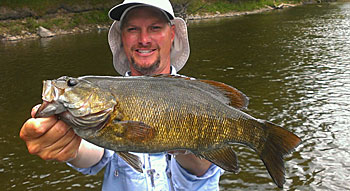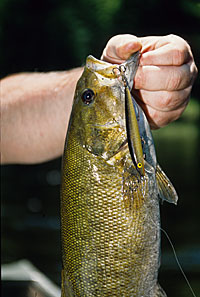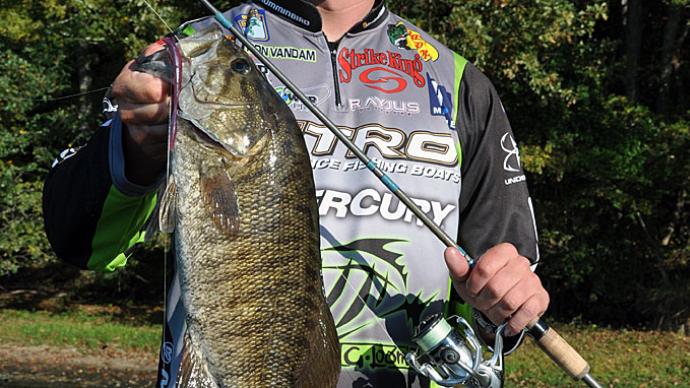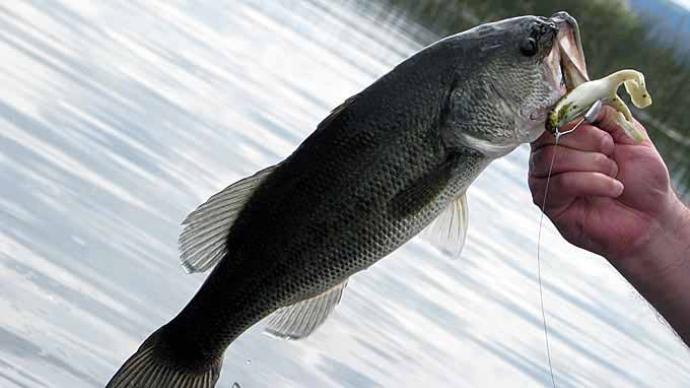
Chad Betts is a multi-species guide and a fishing fanatic. He spends more time on the water than any guide I know. In the fall, he fishes the Muskegon and other northwest Michigan rivers for Chinook salmon beginning in September. He targets steelheads that show up in October through December. If the winter isn't too harsh or severe, Betts will spend at least a few days a week on the river during the winter while sneaking in a trip or two to Florida to tangle with some saltwater species. Betts is on the water seven days a week when spring steelheads arrive in March through early May before targeting resident trout during the peak when the insect hatches explode, and suckers spawn from mid-May until mid-June.
By June, the smallmouth fishing begins to pick up. It's one of Betts' favorite times of the year. From mid-June through mid-September, the weather is beautiful, there are fewer people on the rivers, and clients are grinning from ear to ear while battling feisty bronzebacks.
Betts firmly believes that the brawny smallmouths he catches in the river during the summer and early fall are not there all year round. Smallmouths are not known as migratory species. Still, Betts believes that the smallies spend most of the year in the impoundments between dams and then migrate upstream to take advantage of warming water temperatures and their favorite food- crayfish.

Smallmouth fishing explodes when water temperatures in the rivers reach 68 to 74 degrees, and hot fishing coincides with the first full moon of the summer when crayfish begin their first heavy molt. To a smallmouth, the molt is like plopping a heaping platter of freshly boiled crawdads in front of a Cajun. "Whenever I catch a river smallmouth, regardless of the time of year, they're spitting up crayfish," said Betts.
Michigan rivers provide ideal habitat for crayfish. Most have a lot of rock and gravel substrate directly below dams for several miles before becoming sandier with deep pools before reaching the next dam or the big lake. On the Muskegon River, you'll find excellent smallmouth action in the summer below Rogers, Hardy, and Croton dams to Lake Michigan. Other southern Michigan rivers, like the Kalamazoo and St. Joe, offer similar fishing.
Betts said that trout take-up lies in the middle of the river where there's a current seam or break, but river smallmouths are edge creatures. "Most of the time, you're going to find smallmouths close to shore," advised Betts. "You must be casting anywhere from 10 feet offshore to right on shore to induce strikes even though smallmouths are very aggressive. They are more structure-oriented than trout. Anytime you see a tree, rocks, or a shelf along the shore, it will hold bass. Smallies seem to like that first drop-off as you come off the shoreline. Smallmouths are proactive and get increasingly aggressive as the water warms up. Some of the biggest fish of the year seem to come right at the end of August when water temperatures are the warmest." Betts said smallmouth typically run 12 to 18 inches and 1 to 3 pounds, but 4- and 5-pound smallies are relatively common.
He is constantly moving while his clients are casting. He slows his custom-made drift boat by rowing and positioning so his clients can pound the shoreline and visible structure. He relies mainly on a handful of baits that run the gambit from #5 Rapala X-Raps, spinnerbaits, Rebel Wee-Crawfish, Senkos, and tubes. "Three things a river smallmouth bait needs are vibration, color, and movement," he said.
"Tubes are a go-to lure because they imitate crayfish and gobies that are in the river, they're easy to fish, and they're cheap," Betts joked. "It's not uncommon to lose 15 tubes in a day!" You can hop, pop, drag, or swim tube jigs. It doesn't take a great deal of expertise to fish them. They look like something good to eat, scurrying along the bottom. Dark colors like watermelon, pumpkinseed, and motor oil are good smallie colors. 3.5- or 4-inch tubes are about the right size when matched to an 1/8- or 1/4-ounce tube jig head.
"The Rebel Wee-Crawfish is an old standby," Betts said. "The idea is to cast and bring it across the current, so the lip is digging into and bouncing off the bottom. The bait is a spittin' image of a crayfish trying to escape, and the smallmouth will smash it." True to form, the best colors in the Rebel Wee Crawfish are Cajun, Nest Robber, Ditch, and Green Crawfish. "Whenever we're throwing crankbaits, we use a lot of orange, rust, and brown colors."

Betts said #5 Rapala X-Raps are another consistent crankbait. "The Raps suspend and dive to a maximum of 6 feet. They're a cross between a stickbait and a crankbait. We'll use the 3-1/8 inch, 1/4 ounce and the 4 inch, 6/17 ounce lures, but in more natural colors like gold, silver, shiner, and rainbow trout."
When river smallmouths want a change in menu, they often turn to steelhead and salmon smolts available in the lower reaches of the river when they out-migrate in late spring and early summer. Pearl- and white-colored Senko jerkbaits also do a great job of imitating struggling salmonid smolts and are weedless. Senkos are perfect for working the upper half of the water column and excel when the bronzebacks are aggressively targeting smolts.
"I use spinnerbaits when I want to show them something different or when we're targeting slower water and back eddies," said Betts. He prefers spinnerbaits with a white skirt and a gold willow leaf blade, like the Booyah's Tandem Blade. He adds a pearl Kalin grub trailer for additional action and bulk.
Fishing various crankbaits, spinnerbaits, and plastics require a particular spinning outfit. A longer rod with a fast action is perfect for working tube jigs across the bottom, manipulating crankbaits and stickbaits, and pitching slightly heavier spinnerbaits. St. Croix Rods has two rods in their Legend Elite series that are perfect for river smallies. The ES70MLF and ES70MF come in one- or two-piece models and are built with high-modulus/high-strain SCV graphite and reinforced with super-high modulus SCVI graphite in the lower section. The rods feature IPC, ART, TET, and new Fuji Torzite guides with solid-titanium frames. The rods feature dramatically improved balance, handle ergonomics, and sensitivity.
Match this to your favorite spinning reel with a high-speed retrieve, and you've got an ideal river combo for smallmouths. Closing the bail by hand when you cast will add years to the life of your bail spring on your spinning reel.
Fluorocarbon is a no-brainer for river fishing. It's tough and nearly invisible in the clear waters of summer. You can use anywhere from 6- to 12-pound test line when targeting smallmouths in the river.
Few things top a float down a meandering river on a hot summer day with your toes dangling in the water, especially if feisty smallmouths are tugging on the end of your line.




